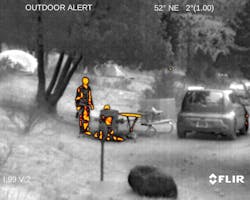How many times in your career have you wished you could see a little better in low-light or no-light scenarios? In both urban and rural settings, thermal imaging devices have helped LEOs during fugitive searches, search and rescue operations, accident investigations, SWAT operations, evidence collection and much more. In Iowa, for example, one chief of police used a thermal imager when a suspect chase turned search and rescue after the man took off into a cornfield in freezing temperatures. Rather than sending his officers into the fields and putting them in harm’s way, the chief used a thermal imager to rule out spaces the suspect was not hiding. Thermal imaging technology, once difficult for law enforcement to obtain, has become lighter, more cost effective and all around better. The FLIR Breach is one such thermal imager, purpose-built for law enforcement, with many modern features at a good price.
Lightweight and convenient
I wanted to see how intuitive the product was so I began using the features before reading the manual. I managed to easily turn the product on and off and scroll through palettes, however, I did need to turn to the manual to figure out how to take a photo or record video: single click the main button to capture a single image snapshot and double click to record video/stop recording. With the up and down arrows, you can also increase and decrease screen brightness as well as increase and decrease zoom.
The Breach is so small it can be concealed in a pocket, worn around the neck or mounted to a helmet with its mini-rail feature.
The Breach features a FLIR Boson core 12um Pitch Thermal Sensor and it also has a digital compass and inclinometer. There’s a settings menu that allows you to make compass calibration and to change the position of the image on the screen, among other things.
Let’s get into the details
The user manual specifications say it’s rated for -20°C to +50°C (-4°F to +122°F). While our range wasn’t quite as significant, we did test it below 32°F and above 80°F and it did well both times.
The Breach offers seven palette options that worked well in day and night – White Hot, Black Hot, Rainbow, Ironbow, Sepia, Arctic and Outdoor Alert. Although I oftentimes switched between palette options, my personal preference was White Hot as I found it was easiest to spot heat signatures in the dark.
What I liked most about the Breach was the ability to detect and recognize heat signatures, and therefore provide situational awareness. One night I woke up to really loud, heavy breathing outside my tent. I turned on the thermal imager, unzipped the tent, poked my head into the darkness and identified that several bison were grazing about 10 yards away. I was able to easily recognize bison about 150 yards away, too. With the naked eye, they would have been impossible to see. Though it’s not a long-range detector, I read that the FLIR Breach has target detection within 300 yards. We were able to recognize heat signatures from elk roughly 250 yards up a hill, though it was a little tough trying to distinguish whether they were deer or elk. Once they started moving we got better confirmation.
Another feature law enforcement will appreciate is the product’s onboard video recording, image capture and internal storage. FLIR notes the Breach has up to 1,000 images and 2.5 hours of video on internal memory, though I did not capture that many images. Uploading the images from the Breach to the computer was extremely easy with the USB connector. FLIR designed the product to not only withstand the rigors of law enforcement, but with ease of usage in mind, too. It takes one CR123A 3V Lithium battery, with the battery operating life reportedly up to 90 minutes at 68°F. We used the product intermittently for multiple days and only had to change the battery once, but we also made sure to have a few spares with us just in case.
The FLIR Breach has a limited 3-year warranty, is listed for $2,495.00 and as many in law enforcement like to see, is made in the U.S. Fifteen years ago thermal imaging technology was not available to law enforcement in such a small size with so many features. It’s a product that improves situational awareness in many light conditions – that alone is one big reason to check out the FLIR Breach.
About the Author

Adrienne Zimmer
Editor
Adrienne Zimmer was the Editor of Law Enforcement Technology magazine, a monthly business-to-business publication that covers technology trends and best practices for public safety managers from 2017 to 2019. LET is part of Officer Media Group, which also publishes Law Enforcement Product News and Officer.com. Adrienne has been in publishing since 2013.
